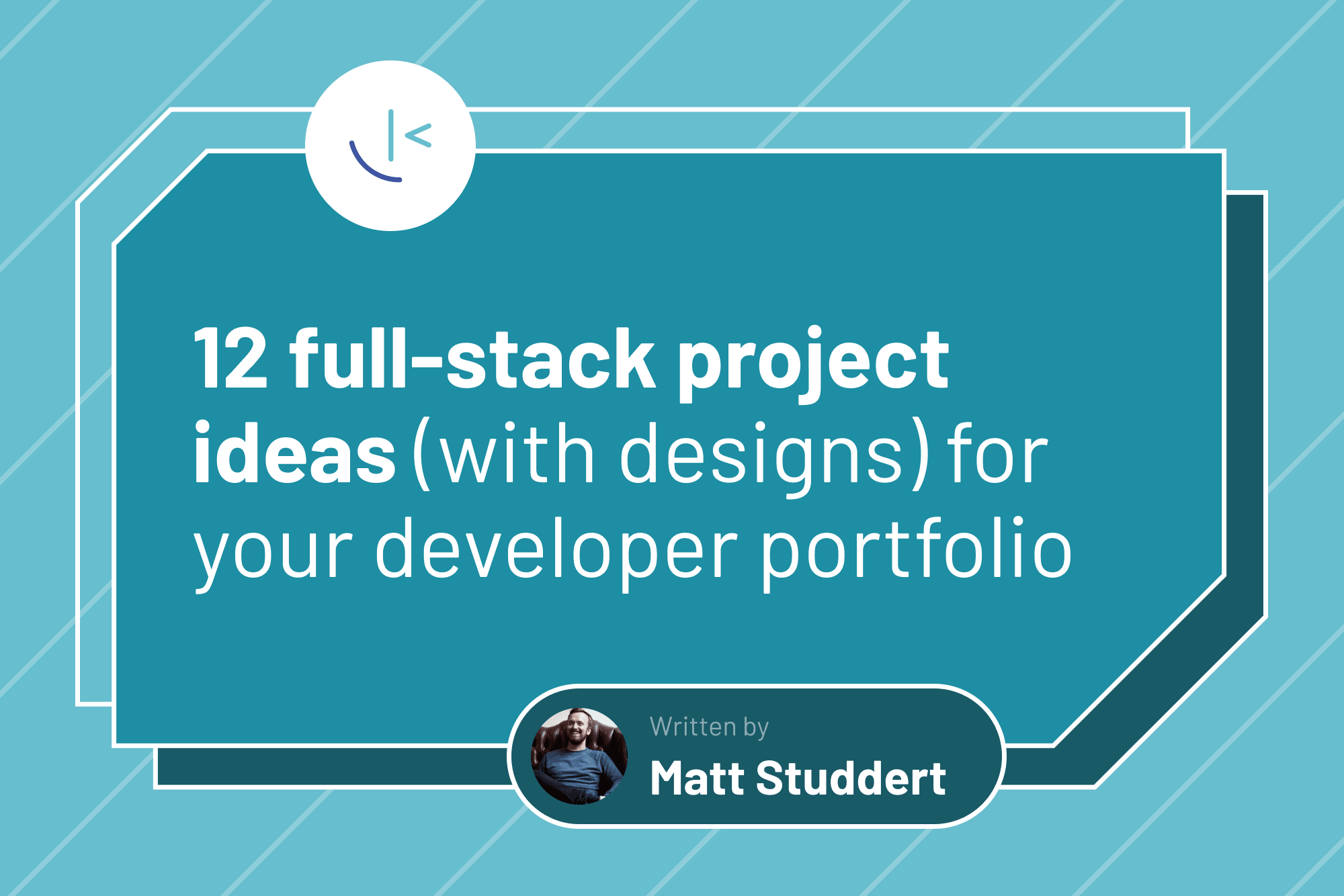
12 full-stack project ideas (with designs) for your developer portfolio
12 full-stack project ideas with professional designs. Learn to add authentication, databases, and APIs to Frontend Mentor challenges for job-ready portfolios.
Table of contents
You need a portfolio to get hired. But most developers struggle with two problems: deciding what to build, and making their projects look professional enough to impress hiring managers.
Hiring managers spend maybe 30 seconds on your portfolio. They're looking for proof you can build complete applications: frontend, backend, database, deployed. If your projects look unpolished or amateur, they move on.
What makes a strong full-stack portfolio project? Projects that demonstrate frontend, backend, database, and deployment skills together. Strong projects include real-world features like authentication, search functionality, data validation, and API design. Each project needs live deployment and public source code to prove you can build and ship complete applications.
These projects prove you can build complete applications—exactly what employers look for.
This guide gives you 12 concrete project ideas with professional designs already built. Each Frontend Mentor challenge provides the design and specifications. You add the frontend, backend, database, and deployment that prove your full-stack skills. The design is handled, so your projects look polished while you focus on the code that actually gets you hired.
Many developers assume Frontend Mentor challenges are only for practicing HTML, CSS, and JavaScript, which is a missed opportunity. The challenges provide professional designs and clear specifications—exactly what you'd get from a design team at a real job. This makes them perfect foundations for full-stack projects where you add authentication, databases, APIs, and deployment.
What makes a project "full-stack"?
Let's define what "full-stack" means for a portfolio project.
Full-stack isn't consuming a public API. That's frontend work. Full-stack means you built both the frontend and the backend, handled data persistence, and deployed everything to production.
Every full-stack portfolio project should demonstrate these four areas:
1. Frontend implementation
Your frontend shows you can build interfaces people actually use:
- Responsive design across devices
- Accessible components following WCAG guidelines
- State management (e.g., React hooks, Redux, Zustand)
- Form handling with client-side validation
- Interactive elements that respond to user actions
2. Backend development
The backend is where the behind-the-scenes work happens:
- API endpoints you designed and built
- Authentication and authorization logic
- Server-side validation and business rules
- Error handling and logging
3. Database management
Prove you can handle data that persists:
- Database schema you designed
- CRUD operations (Create, Read, Update, Delete)
- Data relationships using foreign keys
- Queries that perform well under load
4. Production considerations
Exceptional full-stack portfolio projects are shipped and polished:
- Deployment to real hosting (Vercel, Railway, Render)
- Environment configuration and secrets management
- Error handling that degrades gracefully
- Performance optimization (lazy loading, caching, code splitting)
These 12 Frontend Mentor challenges meet all four requirements when you add full-stack features and the production bells and whistles.
Complete example: Todo app as a full-stack project
Let's walk through one project from start to finish. This shows exactly how to transform a Frontend Mentor challenge into a full-stack portfolio piece.
Starting point: The Todo app challenge provides a complete design with light/dark themes, drag-and-drop reordering, and filtering.
Your potential full-stack implementation:
Frontend (React + TypeScript):
- Component-based architecture with React
- Drag-and-drop with react-beautiful-dnd
- Form management using React Hook Form
- Optimistic UI updates (update immediately, sync with backend after)
- Dark mode toggle persisted in local storage
Backend (Express.js + Node.js):
- RESTful API with endpoints:
POST /api/todos- Create new todoGET /api/todos- Fetch user's todosPATCH /api/todos/:id- Update todo (complete, reorder)DELETE /api/todos/:id- Delete todo
- JWT authentication with HTTP-only cookies
- Input validation using express-validator
- Rate limiting to prevent abuse
Database (PostgreSQL):
-- Users table
CREATE TABLE users (
id UUID PRIMARY KEY DEFAULT gen_random_uuid(),
email VARCHAR(255) UNIQUE NOT NULL,
password_hash TEXT NOT NULL,
created_at TIMESTAMP DEFAULT NOW()
);
-- Todos table
CREATE TABLE todos (
id UUID PRIMARY KEY DEFAULT gen_random_uuid(),
user_id UUID REFERENCES users(id) ON DELETE CASCADE,
text TEXT NOT NULL,
completed BOOLEAN DEFAULT false,
position INTEGER NOT NULL,
created_at TIMESTAMP DEFAULT NOW()
);
-- Index for fast queries
CREATE INDEX idx_todos_user_position ON todos(user_id, position);
Deployment:
- Full-stack (all-in-one): Vercel, Railway, or Render can each host your entire application (frontend, backend, and database)
- Separate deployment: Frontend deployed separately to backend and database
- Environment variables managed through platform dashboards
- CI/CD: GitHub Actions runs tests before deploying
Architecture: Frontend → API calls over HTTPS → Backend → PostgreSQL
What this proves:
- You can design RESTful APIs
- You understand authentication flows
- You can model data relationships
- You know how to deploy full applications
This is a foundation project, so keep it simple. You don't need OAuth, WebSockets, or complex caching. Focus on getting the four core areas right. Once you have one solid full-stack project deployed, the next one becomes easier.
The 12 full-stack project ideas
About these groupings: We've grouped these projects by full-stack implementation complexity, not by Frontend Mentor's challenge difficulty ratings. A challenge marked "intermediate" on Frontend Mentor might be "foundation" here if the full-stack patterns are straightforward. Start with foundation projects to learn core patterns, then move to more complex architectures.
Note: When we talk about "full-stack skills to add," these are ideas you can pick and choose from. You control the tech stack, features, and tools you use. Some of the ideas are advanced and overkill for the projects. However, going overkill is exactly what will teach you more lessons and demonstrate your skills and passion.
Foundation projects: learning core full-stack patterns
These four projects teach fundamental full-stack architecture: how frontends talk to backends, how data persists, and how everything deploys together.
1. Todo app

Challenge URL: https://www.frontendmentor.io/challenges/todo-app-Su1_KokOW
The classic todo app becomes full-stack when you add persistent storage and user accounts. The design leaves room for you to take the project in different directions with full-stack features.
What the challenge includes:
- Add, mark as complete, and delete todos
- Filter by all/active/complete todos
- Clear all completed todos
- Toggle light and dark mode
- Drag and drop to reorder items
Full-stack skills to add:
- Frontend: State management for todo list, form validation, drag-and-drop persistence
- Backend: RESTful API, CRUD endpoints for todos, user session management
- Database: Todo storage (PostgreSQL or MongoDB), user associations, completion status tracking
- Bonus: Real-time sync across browser tabs/devices using WebSockets, JWT authentication, todo categories or priorities
How to present it: "Built a todo task manager with user authentication. Implemented RESTful API design, database CRUD operations, and real-time updates across devices using WebSockets."
This project teaches how data flows from UI interactions through API calls to database storage. The simplicity of todos lets you focus on getting the architecture right.
2. Bookmark manager

Challenge URL: https://www.frontendmentor.io/challenges/bookmark-manager-app
A bookmark manager teaches you hierarchical data, search, and user-generated content.
What the challenge includes:
- Add bookmarks with title, description, URL, and tags
- View all bookmarks with details (favicon, title, URL, description, tags, view count, last visited, date added)
- Search bookmarks by title
- Filter by one or multiple tags
- View and manage archived bookmarks
- Pin/unpin bookmarks
- Edit bookmark details
- Copy URLs to clipboard
- Sort by recently added, recently visited, or most visited
- Toggle light/dark themes
Full-stack skills to add:
- Frontend: Multi-tag filtering logic, search with debouncing, URL validation
- Backend: Favicon fetching service, metadata extraction from URLs, RESTful endpoints for bookmarks/tags/archives
- Database: Many-to-many tag relationships, view count tracking, archive status, pinned status indexing for fast queries
- Bonus: Browser extension for one-click bookmarking, duplicate URL detection, automatic categorization using ML
How to present it: "Created a bookmark manager with advanced filtering, tag system, and search. Implemented many-to-many database relationships, full-text search, and automatic metadata extraction from URLs."
Bookmarks force you to think about complex data relationships. Tags have many bookmarks, bookmarks have many tags, and you need efficient queries for filtering by multiple tags simultaneously.
3. Note-taking web app
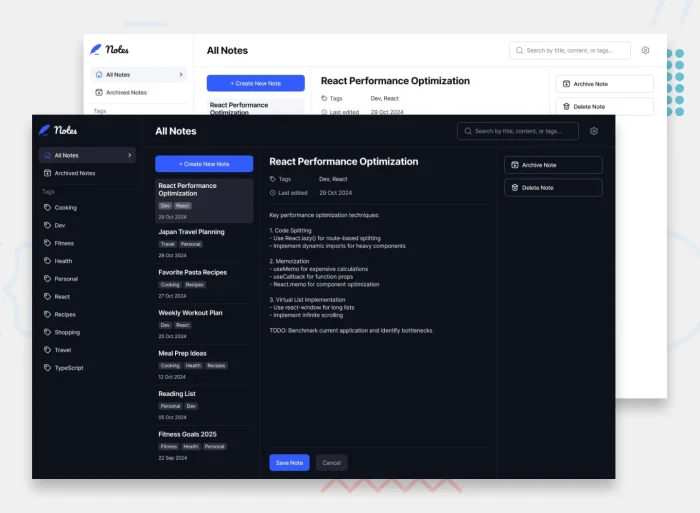
Challenge URL: https://www.frontendmentor.io/challenges/note-taking-web-app-773r7bUfOG
A note-taking app teaches real-time data persistence and rich content handling.
What the challenge includes:
- Create, read, update, and delete notes
- Archive notes
- View all notes and archived notes separately
- View notes filtered by specific tags
- Search notes by title, tag, and content
- Select color and font themes
- Form validation for required fields
- Keyboard navigation for all features
Full-stack skills to add:
- Frontend: Rich text editor integration (TipTap or Slate), auto-save with debouncing, keyboard shortcuts
- Backend: Note versioning API, full-text search with PostgreSQL or Elasticsearch, conflict resolution for concurrent edits
- Database: Note content storage with timestamps, many-to-many tag relationships, search indexing for title and content
- Bonus: Markdown support with preview, note sharing with permission levels (view-only, edit), version history with restore capability
How to present it: "Built a feature-rich note-taking app with auto-save, tagging, and full-text search. Demonstrates real-time data persistence, conflict resolution for concurrent edits, and database indexing for search performance."
Auto-save functionality teaches you about debouncing, optimistic UI updates, and graceful error handling. These patterns appear in most production applications.
4. Markdown editor
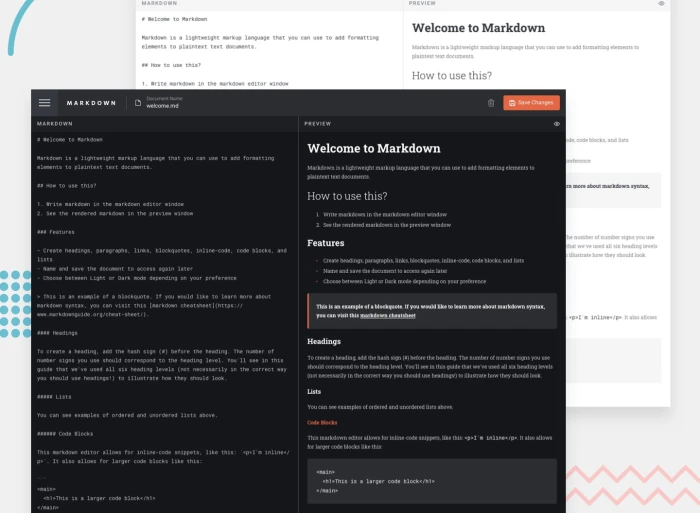
Challenge URL: https://www.frontendmentor.io/challenges/inbrowser-markdown-editor-r16TrrQX9
An in-browser markdown editor shows you can handle text processing and document management.
What the challenge includes:
- Create, read, update, and delete markdown documents
- Name and save documents
- Edit markdown and see formatted preview
- View full-page preview of formatted content
- Toggle between edit/preview modes
Full-stack skills to add:
- Frontend: Split-pane editor layout, live markdown preview rendering, syntax highlighting, keyboard shortcuts
- Backend: Document storage and retrieval API, markdown-to-HTML conversion on server, export to PDF or HTML
- Database: Document storage with versioning, folder organization, document relationships
- Bonus: Template system for common documents, collaborative editing with operational transforms, revision history with diff visualization
How to present it: "Developed an in-browser markdown editor with live preview, document management, and export functionality. Shows understanding of text processing, file handling, and document versioning systems."
This project is great for understanding different approaches to data storage. Do you save on every keystroke, every few seconds, or when the user explicitly saves? Each approach has trade-offs.
Intermediate projects: multi-feature applications
These five projects involve multiple interconnected features, teaching you how to architect more complex applications.
5. Personal blog
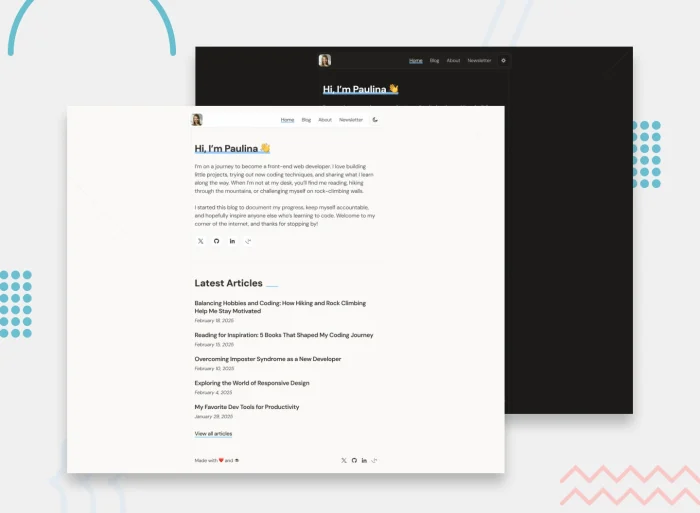
Challenge URL: https://www.frontendmentor.io/challenges/personal-blog-lJpVCnmozL
Building your own personal blog demonstrates content management and publication workflows. You can make it as simple as a static blog or as complex as a full CMS with scheduling, drafts, and analytics.
What the challenge includes:
- Navigate between pages (Home, article pages)
- Read all articles
- Select color theme
- Subscribe to newsletter with email validation
- Form validation with error/success messages
- Multi-page navigation
Full-stack skills to add:
- Frontend: Article listing with pagination, category filtering, responsive image handling, social sharing buttons
- Backend: CMS functionality, content API with pagination, image upload and processing, newsletter API integration (Mailchimp/SendGrid)
- Database: Posts with rich text content, categories and tags, subscriber list management
- Bonus: Draft/published workflow with scheduled publishing, SEO optimization with dynamic meta tags, RSS feed generation, reading time calculation
How to present it: "Created a full-featured blog with CMS, commenting, and newsletter integration. Demonstrates content delivery patterns and automated email workflows."
Building a CMS teaches you about content workflows (draft → review → publish) and how to structure content APIs that scale.
6. Mood tracking app
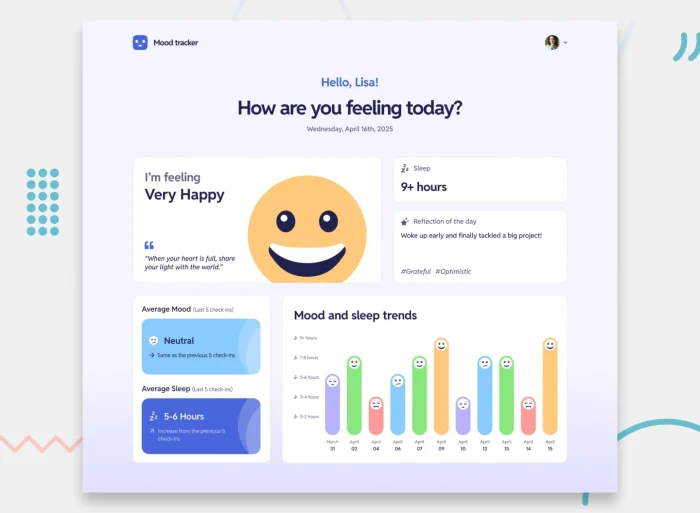
Challenge URL: https://www.frontendmentor.io/challenges/mood-tracking-app-E2XeKhDF0B
A mood tracker introduces time-series data and analytics features.
What the challenge includes:
- Log mood, feelings, reflections, and sleep daily
- See today's mood entry details
- View mood quotes based on current mood
- See graph of most recent 11 records
- Interact with chart bars to see details for that day
- View average mood/sleep from past 5 check-ins vs. previous 5
- Update name and avatar through settings
- Form validation
Full-stack skills to add:
- Frontend: Data visualization with Chart.js or D3, calendar view for historical entries, trend displays with comparison periods
- Backend: Time-series data handling, analytics calculations (rolling averages, streaks, patterns), scheduled notification system for reminders
- Database: Daily mood entries with timestamps, pattern analysis queries with window functions, historical data retention policies
- Bonus: Mood insights using ML (pattern detection), customizable reminder notifications, data export to CSV/JSON, correlation analysis (mood vs. sleep, mood vs. weather API)
How to present it: "Built a mood tracking app with data visualization and trend analysis. Shows proficiency in time-series data handling, analytics implementation using SQL window functions, and scheduled background jobs."
Time-series data has unique challenges. How do you efficiently query for trends across months? How do you handle missing days? How do you visualize patterns over different time periods?
7. Entertainment web app
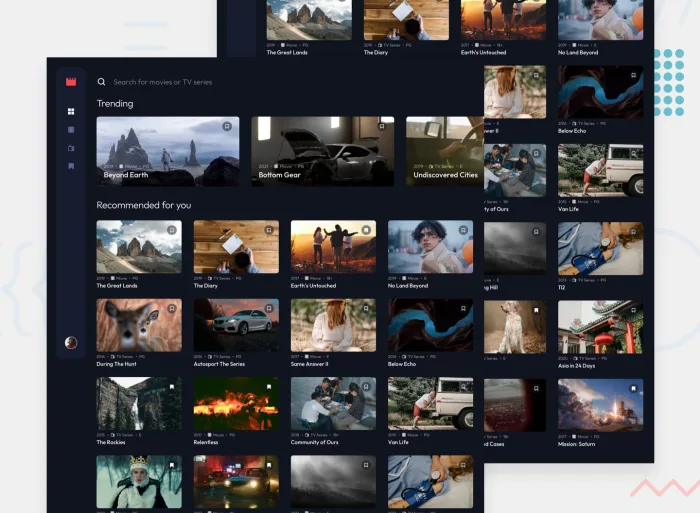
Challenge URL: https://www.frontendmentor.io/challenges/entertainment-web-app-J-UhgAW1X
An entertainment app teaches content organization and user preference tracking.
What the challenge includes:
- Navigate between Home, Movies, TV Series, and Bookmarked Shows pages
- Add/remove bookmarks from all movies and TV series
- Search for shows across all pages
- View content with thumbnail images
- Page-specific filtering
Full-stack skills to add:
- Frontend: Grid layouts for content browsing, search and filter functionality, infinite scroll for large catalogs, responsive image loading
- Backend: Integration with TMDB or OMDb API for real content, caching layer for API responses, rate limiting for external APIs, recommendation logic based on user signals (bookmarks, ratings, search history)
- Database: Bookmarked content with timestamps, user ratings and reviews, search history for personalization, user preferences and genre tracking
- Bonus: Content recommendations based on bookmark patterns and ratings using collaborative filtering, social features (share bookmarks with friends), content alerts for new seasons of bookmarked shows, similar content suggestions based on what users bookmark together
How to present it: "Developed an entertainment web app with content organization, bookmarking, and personalized recommendations. Demonstrates third-party API integration, caching strategies for rate-limited APIs, and recommendation algorithms based on user interaction patterns."
This project teaches you to work with rate-limited external APIs, cache expensive API calls effectively, and build recommendation systems from implicit signals (bookmarks, searches, ratings) rather than explicit viewing data.
8. Product feedback app
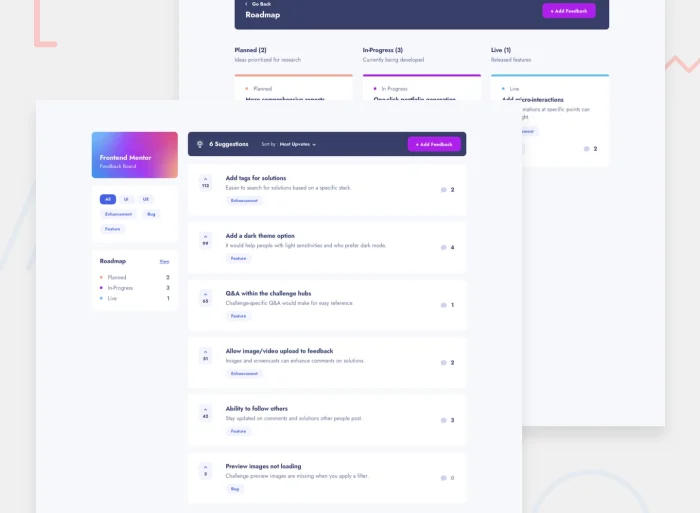
Challenge URL: https://www.frontendmentor.io/challenges/product-feedback-app-wbvUYqjR6
A feedback management system shows you can build social features and voting mechanisms.
What the challenge includes:
- Create, read, update, and delete feedback requests
- Form validations for feedback creation/editing
- Sort suggestions by most/least upvotes and most/least comments
- Filter suggestions by category
- Add comments and replies to feedback
- Upvote feedback requests
- View different suggestion states (suggestion, planned, in-progress, live)
Full-stack skills to add:
- Frontend: Upvoting UI with optimistic updates, threaded comment display, sorting and filtering, status badge UI, form validation
- Backend: Vote tallying with race condition handling using database transactions, comment threading logic, sorting algorithms (hot, top, new), moderation tools, status workflow management
- Database: Feedback items with status field, vote tracking with unique constraints (preventing duplicate votes), comment trees using adjacency list or nested sets, user permission levels
- Bonus: Status workflow automation (planned → in-progress → complete), email notifications for status changes, roadmap view showing in-progress items, admin dashboard for feedback management and analytics
How to present it: "Created a feedback management system with voting, threaded comments, and status workflows. Shows understanding of social features, concurrent action handling with database transactions, and permission-based systems."
Voting systems are trickier than they look. You need to prevent users from voting multiple times using unique constraints, handle race conditions when tallying votes with database transactions, and efficiently sort by vote count with proper indexing.
9. Kanban task management app
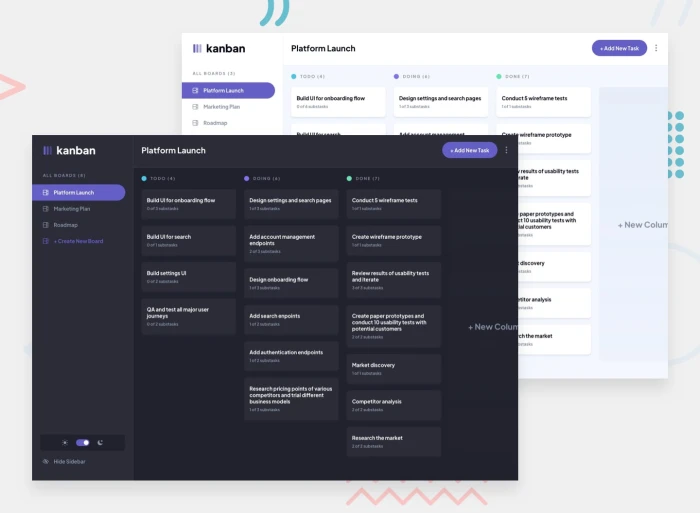
Challenge URL: https://www.frontendmentor.io/challenges/kanban-task-management-web-app-wgQLt-HlbB
A Kanban board demonstrates complex state management and real-time features.
What the challenge includes:
- Create, read, update, and delete boards and tasks
- Form validations for creating/editing boards and tasks
- Mark subtasks as complete
- Move tasks between columns
- Hide/show board sidebar
- Toggle light/dark themes
- Drag and drop to reorder tasks (bonus)
Full-stack skills to add:
- Frontend: Drag-and-drop with react-beautiful-dnd or dnd-kit, multi-board management, task detail modals, real-time updates with optimistic UI
- Backend: Task ordering persistence, board state management, WebSocket connections for real-time collaboration, conflict resolution for concurrent edits
- Database: Boards with column definitions, tasks with position ordering, subtasks with completion tracking, cross-board task relationships for linking related work
- Bonus: Real-time collaboration (see other users' changes live), task assignments to team members, activity logs for audit trails, task comments and attachments, due dates with notifications
How to present it: "Built a Kanban board with drag-and-drop task management, multi-board support, and real-time collaboration. Demonstrates complex state management, WebSocket implementation for live updates, and optimistic UI updates with rollback on errors."
Drag-and-drop with database persistence teaches you about optimistic updates (update the UI immediately, save to database afterward) and conflict resolution when multiple users edit simultaneously. Position ordering requires careful indexing.
Advanced projects: production-scale applications
These three projects involve complex business logic and production requirements that mirror real-world applications.
10. Invoice app

Challenge URL: https://www.frontendmentor.io/challenges/invoice-app-i7KaLTQjl
An invoicing system demonstrates business logic and working with financial calculations.
What the challenge includes:
- Create, read, update, and delete invoices
- Form validations for invoice creation/editing
- Save draft invoices
- Mark pending invoices as paid
- Filter invoices by status (draft/pending/paid)
- Toggle light/dark mode
- Multi-item invoice line items
Full-stack skills to add:
- Frontend: Complex form validation with dynamic line items, invoice status workflows with visual indicators, date pickers for due dates, filter UI for status
- Backend: Invoice calculations with line item totals and tax, invoice number generation with sequential IDs, PDF generation for invoices using libraries like PDFKit or Puppeteer, status change validation (prevent editing paid invoices)
- Database: Client information storage, invoices with status and dates, line items (one-to-many relationship), invoice totals calculated and stored, proper DECIMAL types for currency
- Bonus: Email invoice delivery as PDF attachment using SendGrid/Resend, duplicate invoice functionality to speed up similar invoices, invoice templates for common services, overdue invoice indicators based on due date, simple invoice statistics (total revenue, pending amount, paid this month)
How to present it: "Developed an invoicing system with PDF generation and status workflows. Demonstrates business logic implementation (calculating totals, applying tax), handling financial data with proper decimal precision, and workflow state management with validation rules."
This project teaches you about financial calculations (always use DECIMAL, never FLOAT), state machines (draft → pending → paid transitions with rules), dynamic forms (adding/removing line items), and PDF generation. The complexity comes from getting business logic right: line item totals, tax calculations, preventing invalid state changes, and maintaining data integrity.
11. Link-sharing app
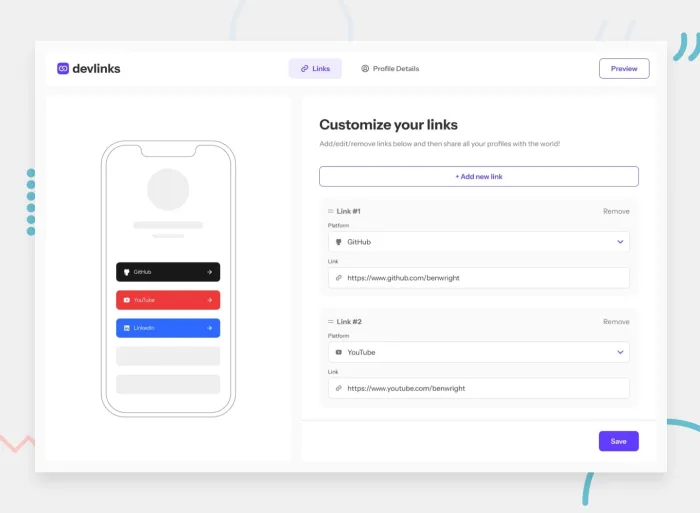
Challenge URL: https://www.frontendmentor.io/challenges/linksharing-app-Fbt7yweGsT
A link-in-bio platform teaches user profiles and link management.
What the challenge includes:
- Create, read, update, delete links
- See preview in mobile mockup
- Form validations (URL pattern matching per platform)
- Drag and drop links to reorder
- Add profile details (picture, first name, last name, email)
- Profile detail validations
- Preview devlinks profile
- Copy profile link to clipboard
Full-stack skills to add:
- Frontend: Profile customization with theme options, drag-and-drop link reordering, live preview mode, image upload with cropping
- Backend: URL validation and sanitization, custom subdomain routing (username.yourapp.com), click analytics tracking with user-agent parsing, public profile API for sharing
- Database: User profiles with unique slugs, links with ordering (position field), click tracking with timestamps and metadata, theme preferences
- Bonus: Custom domain support (bring your own domain), QR code generation for profiles, A/B testing different link orders, integration with social platform APIs for follower counts, scheduled link activation/deactivation
How to present it: "Created a link-sharing platform with analytics, customization, and custom subdomain routing. Demonstrates multi-tenant architecture, analytics implementation with efficient aggregation queries, and URL routing patterns."
This project demonstrates multi-tenancy: each user has their own public page, subdomain, and analytics. You'll learn about slug uniqueness with database constraints, efficient analytics queries with proper indexing, and public vs. authenticated endpoints.
12. Personal finance app
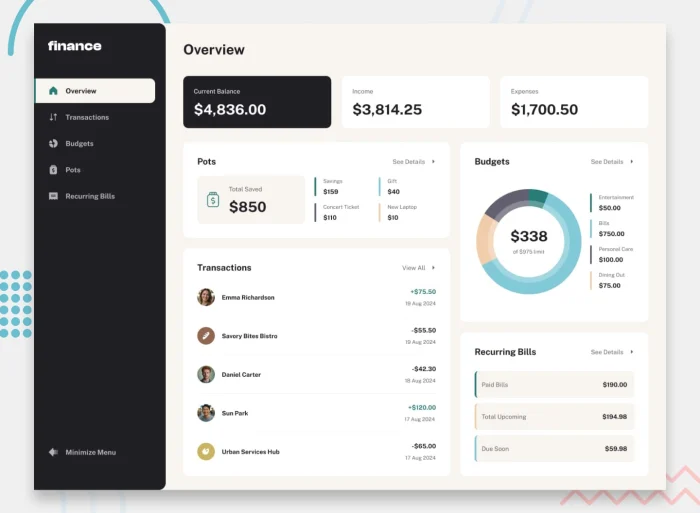
Challenge URL: https://www.frontendmentor.io/challenges/personal-finance-app-JfjtZgyMt1
A finance manager demonstrates complex data relationships and thoughtful data visualization.
What the challenge includes:
- Overview page showing all financial data at-a-glance
- Transactions page with pagination (10 per page)
- Search, sort, and filter transactions
- CRUD operations for budgets and saving pots
- View latest 3 transactions per budget category
- View progress towards each pot goal
- Add/withdraw money from pots
- View recurring bills with status for current month
- Search and sort recurring bills
- Form validation throughout
- Keyboard navigation
Full-stack skills to add:
- Frontend: Complex forms with validation, charts for spending analysis (Chart.js/Recharts), budget vs. actual comparisons with visual indicators, transaction categorization UI, pagination controls
- Backend: CSV transaction import with parsing and validation, budget limit alerts when thresholds exceeded, data aggregation for reports and charts, recurring bill detection from transaction patterns, spending summary calculations
- Database: Accounts with balances, transactions with categories (foreign keys), budgets with time periods and spending limits, pots with target amounts, recurring bills with due dates, complex queries for spending patterns using GROUP BY and window functions
- Bonus: Manual transaction categorization with suggestions based on merchant names, spending insights by category (top spending categories, unusual spending alerts), budget vs. actual visual comparisons with percentage indicators, CSV export for backup, custom budget categories, bill payment reminders with email notifications
How to present it: "Built a personal finance manager with transaction tracking, budget management, and spending analytics. Demonstrates handling sensitive financial data with proper input validation, complex data relationships with foreign keys, and data aggregation using SQL for reporting dashboards."
This project focuses on the data modeling and visualization challenges of personal finance: proper decimal handling for currency, time-based aggregations (spending this month vs. last month), budget tracking with alerts, and presenting complex financial data clearly. You don't need real bank connections to show you understand financial data architecture and can build meaningful analytics.
How to present these projects in your portfolio
Building the projects is half the work. How you present them determines whether you get interviews.
Essential information for each project
Every project in your portfolio needs:
Live demo link: Deploy your project so employers can actually use it. A broken or missing demo link is worse than no link at all. Use platforms like Vercel, Railway, or Render.
GitHub repository: Your code must be public and well-organized. Private repos make it impossible for potential employers to review your code.
Technologies used: List your frontend framework, backend language/framework, database, and any major libraries. Be specific: "React 19 with TypeScript, Express.js, PostgreSQL 15" tells more than "React, Node, Database."
Key features and challenges: In 2-3 sentences, explain what the project does and what made it interesting to build. Don't list features. Explain what you learned or what problems you solved.
Your architecture decisions: Why did you choose PostgreSQL over MongoDB? Why serverless functions instead of a traditional server? Why JWT authentication instead of sessions? These decisions show how you think.
README best practices
Your README is your first impression. Make it count.
Project description: One paragraph explaining what the project does and who it's for. Don't make readers guess.
Setup instructions: Step-by-step commands to run locally. Assume the reader knows nothing about your project. List all environment variables with example values. If it takes more than 5 minutes to get running, document why.
Architecture overview: A simple diagram or explanation of how your frontend talks to your backend, where data lives, and how pieces connect. This is critical for full-stack projects. Show employers you understand the whole system, not individual pieces.
Technical decisions: Pick 2-3 interesting decisions you made and explain them. "I chose PostgreSQL over MongoDB because the relationships between users, projects, and tasks were well-defined and benefited from foreign key constraints and ACID transactions."
Screenshots: Show the major features in action. Include both desktop and mobile views to prove responsive design. Use screenshots to tell the story of your app's workflow.
What to highlight in descriptions
When describing each project on your portfolio site:
Full-stack challenges you solved: "Implemented real-time sync between multiple browser tabs using WebSockets and conflict resolution logic for concurrent edits." This is far better than "Built a todo app."
Technical decisions and trade-offs: "Used optimistic UI updates for instant feedback, with rollback on server errors and retry logic for failed requests." Shows you understand user experience and error handling.
Performance optimizations: "Reduced initial page load from 3.2s to 1.1s by implementing image lazy loading and code splitting for route components." Proves you think about refining and optimizing your projects.
Security considerations: "Added rate limiting on authentication endpoints to prevent brute force attacks. Implemented CSRF protection and secure HTTP-only cookies for session management." Shows security awareness beyond hashing passwords.
What you'd do differently: "Next time, I'd use TypeScript on the backend, not just the frontend. I spent too much time debugging runtime errors that TypeScript would have caught. I'd also implement proper error handling middleware earlier instead of having try-catch blocks everywhere." Demonstrates learning about type safety across the stack and code organization.
If you're a developer with no professional experience, you need to lean into these methods of showcasing your understanding. Professional developers can easily point to quantifiable work they've done in their jobs and add it to their resumes.
But, as a newbie, you need to treat your portfolio projects as real-world apps and write about your learnings and improvements to showcase your knowledge.
Portfolio website structure
Organize your projects intentionally:
Lead with your strongest work: Put your best full-stack project first. This is what gets reviewed in those critical first 30 seconds. Make it count.
Group logically: You can organize by technology (React projects, Vue projects) or by complexity (foundation projects, advanced projects). Make it easy to navigate. Avoid random ordering.
Include action buttons: Every project needs clear "View Live" and "View Code" buttons above the fold. Don't make employers hunt for these links.
Show don't tell: Screenshots prove your design skills. GIFs prove your interactions work. Videos demonstrate complex features such as drag-and-drop and real-time collaboration.
Technical summaries: 2-3 sentences per project explaining the tech stack and key features. Save the deep dive for the README.
Taking it further: adding full-stack features
Frontend Mentor challenges provide professional designs, but the full-stack implementation is yours to define. Here are features you can add to any project to demonstrate advanced full-stack skills.
Authentication & authorization
User accounts transform simple apps into full-stack showcases:
User registration and login: Implement email/password authentication with proper password hashing (bcrypt or Argon2). Include email verification to prevent fake accounts and improve security.
JWT or session management: Choose based on your architecture. JWTs work well for stateless APIs and microservices. Sessions work better for traditional server-rendered apps or when you need instant logout.
Role-based access control: Add admin users who can moderate content and regular users with limited permissions. Implement middleware to check permissions on protected routes. This shows you understand multi-tenant systems.
Password reset workflows: Implement "forgot password" with time-limited email tokens. This involves email sending (SendGrid/Resend), secure token generation, token expiration, and secure token validation. Test the full workflow.
Real-time features
Real-time updates make applications feel modern:
WebSocket connections: Use Socket.io or native WebSockets to push updates from server to client instantly. Implement reconnection logic for dropped connections.
Live updates and notifications: Show users when new content appears without requiring a page refresh. The product feedback app is perfect for this: notify users when someone comments on their feedback.
Collaborative editing: Allow multiple users to work on the same document simultaneously. This involves operational transforms or CRDTs (advanced but impressive). Start with simpler presence indicators (showing who's online).
Activity feeds: Display a stream of recent actions (user X added a task, user Y commented). This demonstrates event-driven architecture and real-time data streaming.
Third-party integrations
Integrating external services shows you can work with APIs:
Email services: Use SendGrid or Resend to send transactional emails (welcome emails, password resets, notifications). Handle delivery failures gracefully.
Cloud storage: Store user-uploaded images on AWS S3, Cloudinary, or Cloudflare R2. This shows you understand file handling beyond local storage and can work with cloud services.
Social authentication: Add "Sign in with Google" or GitHub OAuth. This demonstrates understanding of the OAuth flow, token management, and linking social accounts to user profiles.
External data APIs: Pull in real data from services like weather APIs, news APIs, or the TMDB API for the entertainment app. Implement proper error handling for API failures.
Advanced data features
These features show you can handle complex data:
Full-text search: Implement search across text content using PostgreSQL full-text search or Elasticsearch. The note-taking app is ideal for this. Include relevance ranking and highlighting.
Data export/import: Let users export their data to CSV or JSON and import it back. This demonstrates data transformation skills and gives users confidence in data portability.
Analytics and reporting: Build dashboards that show usage patterns, trends over time, and performance metrics. The mood tracker is perfect for this. Use SQL window functions for rolling averages.
Caching strategies: Implement Redis caching for expensive queries or API calls. Add cache invalidation logic. This shows performance awareness and understanding of caching patterns.
Production polish
These details separate portfolio projects from production applications:
CI/CD pipelines: Set up GitHub Actions to run tests and deploy automatically on push to main. Include linting, type checking, and test coverage reports. This demonstrates DevOps awareness.
Error logging and monitoring: Integrate Sentry or similar to track errors in production. Set up alerts for critical errors. Shows you care about user experience after deployment and can debug production issues.
Performance optimization: Implement lazy loading, code splitting, and image optimization. Measure before and after with Lighthouse. Document the improvements with specific metrics.
Security best practices: Add rate limiting to prevent abuse, input sanitization to prevent XSS, CORS configuration, security headers (CSP, X-Frame-Options), and dependency scanning. These details show production readiness.
I've personally seen community members take our challenges well beyond the brief and add production polish.
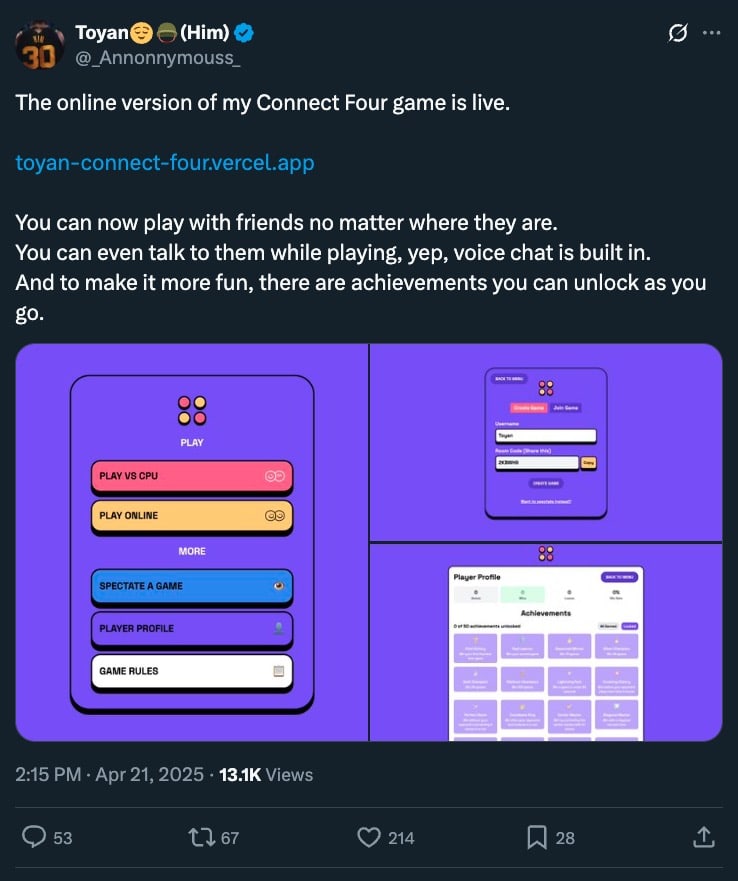
One example is Toyan (above), who completed our Connect Four game project and transformed it into a full-stack multiplayer experience. He added real-time multiplayer features (including the ability to spectate other players' games), an achievement system, and much more. This project would make an incredible portfolio piece, leaving room for valuable interview conversations and discussions to showcase knowledge and passion.
Common mistakes to avoid
Even with great projects, poor presentation can hurt your chances. Here's what to avoid.
Weak project documentation
Generic READMEs damage your credibility. "This is a todo app built with React" tells employers nothing.
Explain your technical decisions. MongoDB for flexible schemas? PostgreSQL for ACID transactions? Express over Fastify? These decisions reveal your thinking.
Include working setup instructions. List environment variables with example values. Explain where to get API keys and how to set up the database. Test your instructions on a fresh machine.
Missing production deployment
Portfolio projects must be deployed and accessible. If an employer can't click a button and see your work running, they'll assume it doesn't work or you don't know how to deploy.
Broken demo links are worse than no links at all. Check your deployments regularly: free-tier services sometimes shut down after inactivity, domains expire, environment variables get cleared, or databases get wiped.
Choose reliable hosting platforms. Don't host on unreliable free services that frequently go down.
Not explaining the full-stack work
Don't assume employers will dig through your backend code. Many won't have time.
Call out full-stack features explicitly. "Includes bcrypt authentication, PostgreSQL with foreign keys, and RESTful API with rate limiting" beats "Full-stack todo app."
Add architecture diagrams. A simple visual showing React → Express API → PostgreSQL → Railway helps employers understand your system at a glance.
Document your backend in the README. Include API endpoints, database schema, deployment setup, and key technical decisions.
Outdated or abandoned projects
Projects with "Last updated 2 years ago" signal you've moved on or given up.
Dead projects on your portfolio send the wrong message. If you're not maintaining code in your portfolio, why would an employer trust you with their codebase?
Update dependencies regularly. A project with dozens of outdated npm packages and security vulnerabilities suggests you don't understand security or maintenance responsibilities.
Add "Last Updated" dates to show maintenance. Even small updates (fixing a bug, updating a README, adding a feature, updating dependencies) show that these are living projects you care about.
FAQ
What should be on a full-stack developer portfolio?
Your portfolio should ideally include 3-5 projects that demonstrate frontend, backend, and database skills. Each project needs a live demo, source code on GitHub, and clear documentation explaining your full-stack implementation. Quality matters more than quantity: three polished projects beat ten half-finished ones.
How many projects should a full-stack portfolio have?
Start with 3 projects from different complexity tiers in this guide. Once you have three solid full-stack projects deployed and documented, you're in great shape. You can always add more later, but aim for depth over breadth. One great project with thorough documentation beats five rushed projects, and can easily be enough to get your foot in the door with a potential employer.
Do I need to build everything from scratch?
No. Using Frontend Mentor challenges as a design foundation is smart: it shows you can work from requirements and specifications, which is exactly what you'll do at a job. The full-stack implementation you add on top (backend, database, authentication) is what proves your abilities. Focus your effort on backend work, not reinventing the design wheel.
Should I include team projects or only solo work?
Include both, but clearly explain your role in team projects. Team projects show you can collaborate and work in a codebase you didn't create entirely yourself. Solo projects prove you can handle the full stack independently. Label each project clearly: "Team project - I built the authentication system and user dashboard" is far better than vaguely claiming ownership.
What is an example of a full-stack project?
A todo task manager with user authentication demonstrates full-stack skills. The frontend uses React with form validation. The backend uses Express.js with JWT authentication and RESTful API endpoints. PostgreSQL stores user accounts and tasks. The complete application deploys to Railway, demonstrating you can build and ship production applications.
What are some fun full-stack project ideas?
Fun full-stack projects include: Kanban boards with drag-and-drop task management and real-time collaboration; mood trackers with data visualization and trend analysis; entertainment apps with bookmarking and personalized recommendations; link-sharing platforms with custom subdomains and analytics; and invoicing systems with PDF generation and email delivery.
How to do full-stack projects?
Full-stack projects require four components: (1) Frontend with responsive design and state management, (2) Backend API with authentication and business logic, (3) Database with proper schema design and relationships, (4) Production deployment on hosting platforms. Start with a design (e.g., a Frontend Mentor challenge), build the frontend, add backend functionality, integrate a database, and deploy everything.
Will full-stack be replaced by AI?
AI tools accelerate full-stack development, but portfolios still prove you can architect systems, debug production issues, and ship complete applications. These skills require judgment, problem-solving, and understanding of trade-offs that AI can't replace. Full-stack developers who use AI effectively will be more productive, but the fundamental skills remain essential.
Start building your full-stack portfolio
Your portfolio proves your skills. Your website packages them.
These 12 Frontend Mentor challenges provide professional designs and clear requirements. Your job is to add the backend functionality, database integration, and production deployment that prove you're full-stack ready.
Here's what to do right now:
Next 30 minutes:
- Pick the Todo app challenge (simplest foundation project)
- Read the requirements and download the starter files
- Create your GitHub repository with a README template
This weekend:
- Build the frontend using the design provided
- Set up Express.js and PostgreSQL locally
- Create your first API endpoint (GET /api/todos)
- Test the connection between frontend and backend
Next week:
- Add user authentication with JWT
- Deploy Vercel, Railway, or Render
- Write your README with an architecture diagram
- Share your live project
Don't wait for perfect. Ship functional code, document it well, and iterate as you learn. Your portfolio evolves with you.
Pick the Todo app and start building today. Happy coding!
Take your skills to the next level
- AI-powered solution reviews
- 50+ portfolio-ready premium projects
- Professional Figma design files